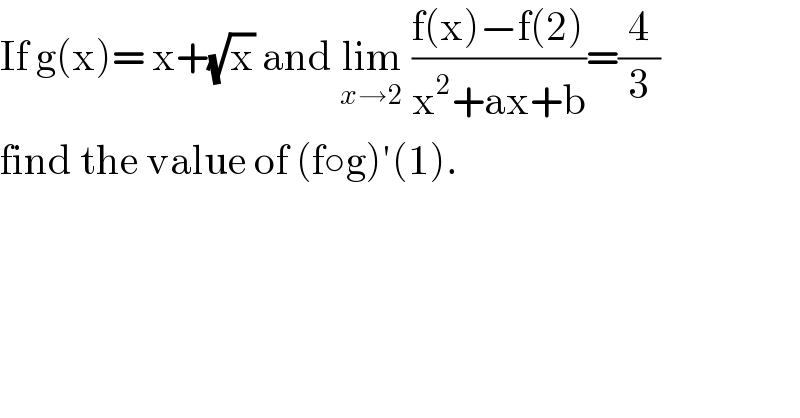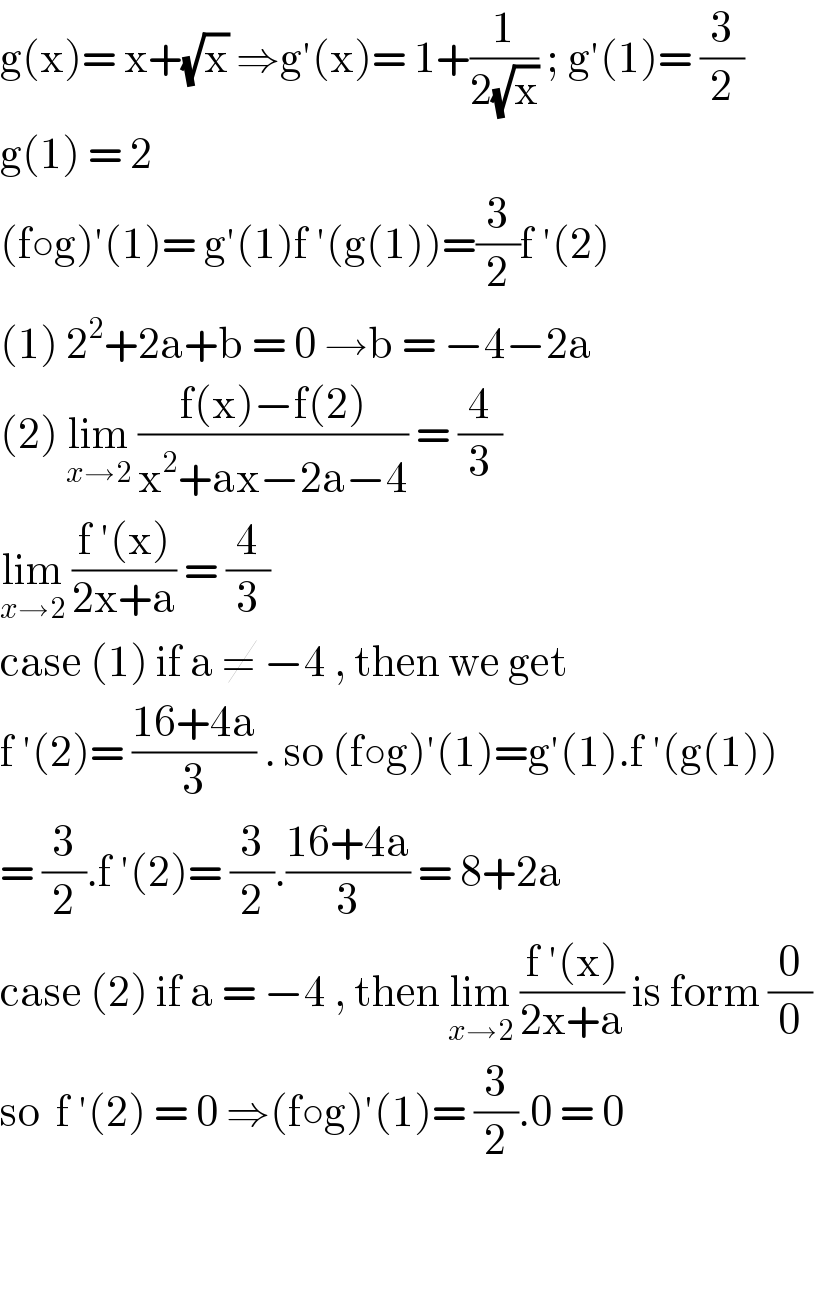
Previous in Relation and Functions Next in Relation and Functions
Question Number 106309 by bemath last updated on 04/Aug/20

$$\mathrm{If}\:\mathrm{g}\left(\mathrm{x}\right)=\:\mathrm{x}+\sqrt{\mathrm{x}}\:\mathrm{and}\:\underset{{x}\rightarrow\mathrm{2}} {\mathrm{lim}}\:\frac{\mathrm{f}\left(\mathrm{x}\right)−\mathrm{f}\left(\mathrm{2}\right)}{\mathrm{x}^{\mathrm{2}} +\mathrm{ax}+\mathrm{b}}=\frac{\mathrm{4}}{\mathrm{3}} \\ $$$$\mathrm{find}\:\mathrm{the}\:\mathrm{value}\:\mathrm{of}\:\left(\mathrm{f}\circ\mathrm{g}\right)'\left(\mathrm{1}\right). \\ $$
Answered by bobhans last updated on 05/Aug/20

$$\mathrm{g}\left(\mathrm{x}\right)=\:\mathrm{x}+\sqrt{\mathrm{x}}\:\Rightarrow\mathrm{g}'\left(\mathrm{x}\right)=\:\mathrm{1}+\frac{\mathrm{1}}{\mathrm{2}\sqrt{\mathrm{x}}}\:;\:\mathrm{g}'\left(\mathrm{1}\right)=\:\frac{\mathrm{3}}{\mathrm{2}} \\ $$$$\mathrm{g}\left(\mathrm{1}\right)\:=\:\mathrm{2}\: \\ $$$$\left(\mathrm{f}\circ\mathrm{g}\right)'\left(\mathrm{1}\right)=\:\mathrm{g}'\left(\mathrm{1}\right)\mathrm{f}\:'\left(\mathrm{g}\left(\mathrm{1}\right)\right)=\frac{\mathrm{3}}{\mathrm{2}}\mathrm{f}\:'\left(\mathrm{2}\right) \\ $$$$\left(\mathrm{1}\right)\:\mathrm{2}^{\mathrm{2}} +\mathrm{2a}+\mathrm{b}\:=\:\mathrm{0}\:\rightarrow\mathrm{b}\:=\:−\mathrm{4}−\mathrm{2a} \\ $$$$\left(\mathrm{2}\right)\:\underset{{x}\rightarrow\mathrm{2}} {\mathrm{lim}}\:\frac{\mathrm{f}\left(\mathrm{x}\right)−\mathrm{f}\left(\mathrm{2}\right)}{\mathrm{x}^{\mathrm{2}} +\mathrm{ax}−\mathrm{2a}−\mathrm{4}}\:=\:\frac{\mathrm{4}}{\mathrm{3}} \\ $$$$\underset{{x}\rightarrow\mathrm{2}} {\mathrm{lim}}\:\frac{\mathrm{f}\:'\left(\mathrm{x}\right)}{\mathrm{2x}+\mathrm{a}}\:=\:\frac{\mathrm{4}}{\mathrm{3}}\: \\ $$$$\mathrm{case}\:\left(\mathrm{1}\right)\:\mathrm{if}\:\mathrm{a}\:\neq\:−\mathrm{4}\:,\:\mathrm{then}\:\mathrm{we}\:\mathrm{get}\: \\ $$$$\mathrm{f}\:'\left(\mathrm{2}\right)=\:\frac{\mathrm{16}+\mathrm{4a}}{\mathrm{3}}\:.\:\mathrm{so}\:\left(\mathrm{f}\circ\mathrm{g}\right)'\left(\mathrm{1}\right)=\mathrm{g}'\left(\mathrm{1}\right).\mathrm{f}\:'\left(\mathrm{g}\left(\mathrm{1}\right)\right) \\ $$$$=\:\frac{\mathrm{3}}{\mathrm{2}}.\mathrm{f}\:'\left(\mathrm{2}\right)=\:\frac{\mathrm{3}}{\mathrm{2}}.\frac{\mathrm{16}+\mathrm{4a}}{\mathrm{3}}\:=\:\mathrm{8}+\mathrm{2a} \\ $$$$\mathrm{case}\:\left(\mathrm{2}\right)\:\mathrm{if}\:\mathrm{a}\:=\:−\mathrm{4}\:,\:\mathrm{then}\:\underset{{x}\rightarrow\mathrm{2}} {\mathrm{lim}}\:\frac{\mathrm{f}\:'\left(\mathrm{x}\right)}{\mathrm{2x}+\mathrm{a}}\:\mathrm{is}\:\mathrm{form}\:\frac{\mathrm{0}}{\mathrm{0}} \\ $$$$\mathrm{so}\:\:\mathrm{f}\:'\left(\mathrm{2}\right)\:=\:\mathrm{0}\:\Rightarrow\left(\mathrm{f}\circ\mathrm{g}\right)'\left(\mathrm{1}\right)=\:\frac{\mathrm{3}}{\mathrm{2}}.\mathrm{0}\:=\:\mathrm{0} \\ $$$$ \\ $$$$ \\ $$
